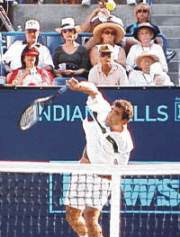<% ns_puts [mkm_getnavbar] %>

Advanced Tennis:Sampras Serve
The Racket Path
by John Yandell
Page 3
Key Position 3: Followthrough

Pete's finish: Full, relaxed, and very smooth |
The final key position in the swing path is the
finish. Watch the animation of
Pete’s serve or study the digital movies in ProStrokesGallery
and you will be struck by his full, relaxed finish.
Pete himself has described the feeling in his arm when he is
serving well as “nice and loose.” The power is not about muscle
contraction or tension - it’s a free, fast flow through the entire
motion.
On most first serves, Pete finishes well across his
body. His racket hand finishes in
line with the center of his left front leg.
On the second serve, or when he is serving the middle in the deuce
court, or wide in the ad court, the follow-through can be shorter. But it
still has that loose look and feel.

The racket head continues all the way across the body finishing in line with the center of the left leg. Pete’s follow-through is long, full and relaxed, ensuring maximum racket head speed. |
To learn the feeling of a full relaxed finish, the
average player should model Pete’s most extended follow-through
position, with the racket hand reaching the center of the front leg. The
vast majority of recreational players are simply far too tense during the
service motion. This tension robs
them of racket head speed and therefore both velocity and spin.
A final word on another disputed serving topic: “pronation.”
As explained above, a key element in the movement from the drop to
the contact is the rotation of the hand and arm from left to right.
No doubt this rotating motion continues after contact. This is the so-called “pronation” effect, in which the face of
the racket actually turns to face the right side fence before moving to
the finish position.
Sampras, like other good servers at all levels of the game, does in fact pronate heavily. But pronation in the service motion is actually an effect of a good motion rather than a cause. If the drop is complete, if the movement to the contact accelerates naturally, if the contact then pronation
|
Pronation is the natural consequence of a great racket head path, not the cause. |
The basic keys to maximizing service velocity, spin, and overall effectiveness are the three core positions along the swing path: the drop, the contact point, and the follow-through. They provide the foundation for developing the more advanced elements of the serve that Pete has also perfected, as we’ll see in upcoming articles.
In the next lesson, we’ll examine the critical motion of the left or opposite arm, both in delivering the toss and in the context of the whole body motion.
Page 1 - Page 2
To view the complete ProStrokes Gallery of digitally mastered Pete Sampras serves, click here.
Your comments are welcome. Let us know what you about think John Yandell's article by emailing us here at TennisONE.
Last Updated 7/1/00. To contact us, please email to: webmaster@tennisone.com
TennisONE is a registered trademark of TennisONE and SportsWeb ONE; Copyright 1995. All rights reserved.

